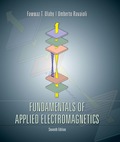
Concept explainers
An electron with a speed of 8 × 106 m/s is projected along the positive x direction into a medium containing a uniform magnetic flux density
The initial acceleration vector of the electron.
Answer to Problem 1P
The initial acceleration vector of the electron is
Explanation of Solution
Given data:
The speed of electron in the positive
The magnetic flux density is
The charge of electron is
The mass of an electron is
Calculation:
The cross product is given as,
Here,
The acceleration vector of the particle is given as,
Here,
Substitute
Conclusion:
Therefore, the initial acceleration vector of the electron is
Want to see more full solutions like this?
Chapter 5 Solutions
Fundamentals of Applied Electromagnetics (7th Edition)
Additional Engineering Textbook Solutions
Starting Out with Programming Logic and Design (5th Edition) (What's New in Computer Science)
Starting Out with C++ from Control Structures to Objects (9th Edition)
Thinking Like an Engineer: An Active Learning Approach (4th Edition)
Java How to Program, Early Objects (11th Edition) (Deitel: How to Program)
Management Information Systems: Managing The Digital Firm (16th Edition)
Web Development and Design Foundations with HTML5 (8th Edition)
- NO AI. Thank Youarrow_forwardPlease solve in detailarrow_forwardHere the Req is 8 my prof solved it and got R3 is parallel to R4 in series with R2 and this combination is parallel to R1. i don't understand how he got these relationships. initially i did the opposite i took (R1//R4 + R2 ) + R3 but got the wrong answer why is it wrong? can you explain to me if there's a trick i can do to understand these questions better and know the configurations of the resistors in a better manner?arrow_forward
- Here the Req is 8 my prof solved it and got R3 is parallel to R4 in series with R2 and this combination is parallel to R1. i don't understand how he got these relationships. initially i did the opposite i took (R1//R4 + R2 ) + R3 but got the wrong answer why is it wrong? can you explain to me if there's a trick i can do to understand these questions better and know the configurations of the resistors in a better manner?arrow_forwardThe ROC of Laplace transform of x(t) = -e²u(t) + e02tu(t) + e.tu(t) is a) 0.1 0.2arrow_forwardFind the inverse Laplace transform of F(s) = s+1 (s-1)(s-2)(s-3) for each ROC: i) Re[s] =>3 ii) Re[s] =σ<1 iii) 1 < Re[s] =σ< 2.arrow_forward
- Find Laplace transform of x(t) = −e¯btu(−t) + e¯atu(t) (), and Rocarrow_forwardPlease solve in detailarrow_forwardA left-sided signal x(t)=-e¯bt u(-t): 0 == X(s) -e-bu(t)e-st dt =- -Le-c 1 -(b+o+jw)t dt = = -00 -∞ (a + b) + jw 1 s+b For this integral to converge, it is necessary that b +σ <0; i.e., ROC: Re[s]=σ < −b. 2 How ?arrow_forward
 Introductory Circuit Analysis (13th Edition)Electrical EngineeringISBN:9780133923605Author:Robert L. BoylestadPublisher:PEARSON
Introductory Circuit Analysis (13th Edition)Electrical EngineeringISBN:9780133923605Author:Robert L. BoylestadPublisher:PEARSON Delmar's Standard Textbook Of ElectricityElectrical EngineeringISBN:9781337900348Author:Stephen L. HermanPublisher:Cengage Learning
Delmar's Standard Textbook Of ElectricityElectrical EngineeringISBN:9781337900348Author:Stephen L. HermanPublisher:Cengage Learning Programmable Logic ControllersElectrical EngineeringISBN:9780073373843Author:Frank D. PetruzellaPublisher:McGraw-Hill Education
Programmable Logic ControllersElectrical EngineeringISBN:9780073373843Author:Frank D. PetruzellaPublisher:McGraw-Hill Education Fundamentals of Electric CircuitsElectrical EngineeringISBN:9780078028229Author:Charles K Alexander, Matthew SadikuPublisher:McGraw-Hill Education
Fundamentals of Electric CircuitsElectrical EngineeringISBN:9780078028229Author:Charles K Alexander, Matthew SadikuPublisher:McGraw-Hill Education Electric Circuits. (11th Edition)Electrical EngineeringISBN:9780134746968Author:James W. Nilsson, Susan RiedelPublisher:PEARSON
Electric Circuits. (11th Edition)Electrical EngineeringISBN:9780134746968Author:James W. Nilsson, Susan RiedelPublisher:PEARSON Engineering ElectromagneticsElectrical EngineeringISBN:9780078028151Author:Hayt, William H. (william Hart), Jr, BUCK, John A.Publisher:Mcgraw-hill Education,
Engineering ElectromagneticsElectrical EngineeringISBN:9780078028151Author:Hayt, William H. (william Hart), Jr, BUCK, John A.Publisher:Mcgraw-hill Education,





